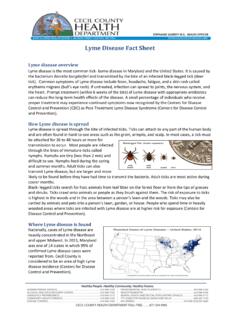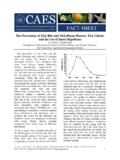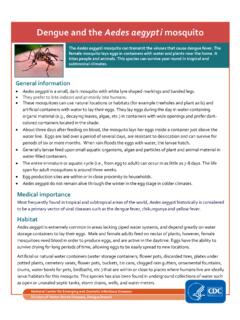Transcription of NPIC Technical Fact Sheet for Picaridin - fleascience.com
1 PICARIDINTECHNICAL fact SHEET1 Chemical Class and Type: Picaridin is an insect and acarid repellent in the piperidine chemical The chemical name is 1-piperidinecarboxylic acid 2-(2-hydroxyethyl)-1-methylpropylester and its Chemical Abstracts Service (CAS) registry number is The World Health Organization (WHO) refers to this chemical as icaridin. Other synonyms include pikaridin, propidine, hydroxy-ethyl isobutyl piperidine carboxylate (INCI), and the trade names Bayrepel and KBR ,3 Piperidine-based compounds such as Picaridin are cyclic amines. Piperidines are structural components of piperine, the plant extract from the genus Piper that is also known as Picaridin itself is a synthetic molecule developed by Bayer in the 1980s based on molecular was first registered for use by the United States Environmental Protection Agency ( EPA) in 2001.
2 1 Picaridin has been registered for use in many countries world-wide but products containing Picaridin first became available in the market in It is widely used in Europe and See the text box on Laboratory / Chemical Properties: Technical grade Picaridin is a colorless liquid with little odor. 1 It is a racemic mix-ture of two diastereoisomers that occur in roughly equal Vapor pressure 2: x 10-4 mmHg at 25 COctanol-Water Partition Coefficient (log K ow)1: ; (log K ow)2: at 20 C and pH 4-9 Henry s constant 6: estimated as x 10-11 atm m3/mol at 25 CMolecular weight 1: g/molSolubility (water) 1: not soluble in water Soil Sorption Coefficient (K oc)6: estimated at 389 Uses: Picaridin is registered for use on the human body and clothing to repel biting flies, ticks, chiggers, fleas, and mosquitoes.
3 1,7 Product formulations include pump sprays, aerosols, and impregnated Uses for individual Picaridin products vary widely. Always read and follow the label directions when applying pesticide words for products containing Picaridin may range from Caution to Danger. The signal word reflects the combined toxicity of the active ingredient and other ingredients in the product. See the pesticide label on the product and refer to the NPIC fact sheets on Signal Words and Inert or Other find a list of products containing Picaridin which are registered in your state, visit the website and search by active ingredient. NPIC Technical fact Sheets provide information that is complex and intended for individuals with a scientific background and/or familiarity with toxicology and risk assessment.
4 This document is intended to promote informed decision-making. Please refer to the General fact Sheet for less Technical Testing: Before pesticides are registered by the EPA, they must undergo laboratory testing for short-term (acute) and long-term (chronic) health effects. Laboratory animals are purposely given high enough doses to cause toxic effects. These tests help scientists judge how these chemicals might affect humans, domestic animals, and wildlife in cases of Structure - Picaridin2 PICARIDINTECHNICAL fact SHEETMode of Action:Target OrganismsPicaridin both repels and deters insects, so that insects move away from the chemical and do not feed if they encounter skin or clothing that has been Picaridin applied to cloth deterred insects from biting through the cloth to the appear to detect the chemical through olfactory sensing.
5 8 Researchers studying the mosquito Aedes aegypti deter-mined that Picaridin stimulates sensory hairs on the mosquito s antennae, and this appears to prevent the mosquito from recognizing its host s have concluded that mosquito species differ in how they sense stimuli. The removal of maxillary bulbs in Aedes aegypti reduced the repellent effect of Picaridin , whereas Anopheles stephensi appeared to sense both their prey and the repellents with different to Picaridin did not kill Aedes aegypti mosquitoes or alter their behavior when the mosquitoes were kept in vials with filter paper that had been soaked with solutions of 2-7% of the OrganismsNo data were found regarding the mode of action of Picaridin on non-target organisms.
6 Acute Toxicity:Oral Picaridin is classified as slightly toxic if ingested. 1 WHO reported LD50 values of 2236 mg/kg and 4743 mg/kg in fasted and non-fasted male rats, See the text boxes on Toxicity Classification and LD50 NOEL for acute oral exposure was estimated at 100 mg/kg in both fasted and non-fasted See the text box on NOAEL, NOEL, LOAEL, and LOEL (page 3).DermalAcute dermal LD 50 values in rats were greater than 2000 mg/kg and 5000 mg/kg. No effects were seen at either the 2000 mg/kg or 5000 mg/kg dose level, so researchers estimated NOEL values of 2000 mg/kg and 5000 mg/kg, respectively for the two The EPA considered Picaridin to be slightly toxic for acute dermal and ocular exposure.
7 1 Picaridin is not considered a skin irritant and is not a sensitizer, but it can cause slight to moderate eye irritation. 1,2 Inhalation The LC 50 over a 4-hour exposure period exceeded 4364 mg/m3 in male rats, and the NOEL was determined to be 2153 EPA considered Picaridin to be practically non-toxic for inhalation exposure. 1 Signs of Toxicity - Animals Rabbits showed no signs of dermal irritation following a single application of Picaridin at a rate of 80 mg/cm 2 during a primary dermal irritation No other reports of acute toxicity in animals were : A common measure of acute toxicity is the lethal dose (LD50) or lethal concentration (LC50) that causes death (resulting from a single or limited exposure) in 50 percent of the treated animals.
8 LD50 is generally expressed as the dose in milligrams (mg) of chemical per kilogram (kg) of body weight. LC50 is often expressed as mg of chemical per volume ( , liter (L)) of medium ( , air or water) the organism is exposed to. Chemicals are considered highly toxic when the LD50/LC50 is small and practically non-toxic when the value is large. However, the LD50/LC50 does not reflect any effects from long-term exposure ( , cancer, birth defects or reproductive toxicity) that may occur at levels below those that cause fact SHEET3 Signs of Toxicity - HumansResearchers noted no dermal irritation on the backs of human subjects following the application of 20% Picaridin aerosol, 20% Picaridin lotion, or Technical grade Picaridin administered at the rate of 50 mg/cm2.
9 The substances were left in place for 48 hours. A total of 80 people participated, with 30 exposed to formulated products and 50 exposed to the Technical grade Picaridin . Subjects included individuals with skin conditions such as eczema, general sensitivity, and 39-year-old man developed allergic contact dermatitis several hours after using a repellent containing 10% Picaridin and methylglucose dioleate. Patch tests suggested that the man had reacted to both the Picaridin and the methylglucose dioleate in the follow label instructions. If unintended exposures occur, be sure to follow the First Aid instructions on the product label carefully.
10 For additional treatment advice, contact the Poison Control Center at 1-800-222-1222. If you wish to discuss an incident with the National Pesticide Information Center, please call Toxicity:AnimalsSubchronic oral exposure led to decreased body weights in both male and female rats when the rats consumed 1033 mg/ In addi-tion, the kidneys of the male rats increased in weight and there was evidence of protein droplet degenerative Based on the doses in this study, researchers estimated the NOAEL to be 301 mg/kg/day, and the LOAEL to be 1033 mg/ See the text box on NOAEL, NOEL, LOAEL, and dermal exposure in rats led to slight increases in liver size, chronic kidney inflammation, and hyalinosis in the kidneys at doses of 500 mg/kg/day for 90 days.









